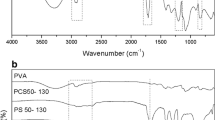Abstract
The properties of hydrophobically associating copolymer P(acrylamide (AM)/2-phenoxylethylacrylate (POEA)), composed of acrylamide and a small amount of POEA (⩽1.0 mol.%) as hydrophobe, were investigated in aqueous solution under various conditions. The results showed that the solution properties were strongly affected by the microstructure of copolymer. The copolymers (BP series) with hydrophobic microblocky structure exhibited large viscosity enhancement due to the intermolecular hydrophobic association, while that did not occur for the random copolymers (RP series). The hydrophobic association thickening behaviors were also remarkably dependent on the number and length of the hydrophobic block in polymer chain. Nonlinear viscosity relationship was found as increasing hydrophobe content and SMR (surfactant/hydrophobic monomer molar ratio), and a maximum appeared at the middle position as a result of the competitive effect between inter- and intra- molecular hydrophobic associations. Solution properties were further studied as a function of the polymer concentration, salinity, temperature and shear rate. The block copolymers show high salt tolerance and shear thinning as well as recovery after shear.
Similar content being viewed by others
References
Selb J, Candau F. Iner-and intra-molecular aggregation of associating polymers in water. In: Glass J E, ed. Associatie Polymers in Aqueous Media, ACS Symposium Series 765. Washington, DC: American Chemical Society, 2000, 95–108
Annable T, Buscall R, Ettelaie R. Rheology of transient networks formed by the association of hydrophobically modified water soluble polymers. In: Alexandridis P, Lindman B, eds. Amphiphilic Block Copolymers, Self-assembly and Applications. Amsterdam: Elsevier, 2000, 281–304
Hashidzume A, Noda T, Morishima Y. Stimuli-responsive associative behavior polyelectrolyte-bound nonionic surfanctant moieties in aqueous media. In: McCormick C L, ed. Stimuli-Responsive Water Soluble and Amphiphilic Polymers, ACS Symposium Series 780. Washington, DC: American Chemical Society, 2001, 14–37
Molchanov V S, Philippova O E, Khokhlov A R, et al. Selfassembled networks highly responsive to hydrocarbons. Langmuir, 2007, 23(1): 105–111
Miquelard-Garnier G, Demoures S, Creton C, et al. Synthesis and rheological behavior of new hydrophobically modified hydrogels with tunable properties. Macromolecules, 2006, 39(23): 8128–8139
Kujawa P, Audibert-Hayet A, Selb J, et al. Effect of ionic strength on the rheological properties of multisticker associative polyelectrolytes. Macromolecules, 2006, 39(1): 384–392
Biggs S, Hill A, Selb J, et al. Copolymerization of acrylamide and an hydrophobic monomer in an aqueous micellar medium: effect of the surfactant on the copolymer microstructure. The Journal of Physical Chemistry, 1992, 96(3): 1505–1511
Chang Y H, McCormick C L. Water-soluble copolymers. 49. Effect of the distribution of the hydrophobic cationic monomer dimethyldodecyl(2-acrylamidoethyl)ammonium bromide on the solution behavior of associating acrylamide copolymers. Macromolecules, 1993, 26(22): 6121–6126
Regalado E J, Selb J, Candau F. Viscoelastic behavior of semidilute solutions of multisticker polymer chains. Macromolecules, 1999, 32(25): 8580–8588
Candau F, Selb J. Hydrophobically-modified polyacrylamides prepared by micellar polymerization. Advances in Colloid and Interface Science, 1999, 79(2–3): 149–172
Regalado E J, Selb J, Candau F. Phase behavior and rheological properties of aqueous solutions containing mixtures of associating polymers. Macromolecules, 2000, 33(23): 8720–8730
Evani S. Eur Patent, 57 875, 1982
Evani S. US Patent, 4 432 881, 1984
Hill A, Candau F, Selb J. Properties of hydrophobically associating polyacrylamides: influence of the method of synthesis. Macromolecules, 1993, 26(17): 4521–4532
Ezzell S A, Hoyle C E, Creed D, et al. Water-soluble copolymers. 40. Photophysical studies of the solution behavior of associative pyrenesulfonamide-labeled polyacrylamides. Macromolecules, 1992, 25(7): 1887–1895
Branham K D, Shafer G S, Hoyle C, et al. Water-soluble copolymers. 61. Microstructural investigation of pyrenesulfonamide-labeled polyelectrolytes. Variation of label proximity utilizing micellar polymerization. Macromolecules, 1995, 28(18): 6175–6182
Volpert E, Selb J, Candau F. Associating behaviour of polyacrylamides hydrophobically modified with dihexylacrylamide. Polymer, 1998, 39(5): 1025–1033
Volpert E, Selb J, Candau F. Influence of the hydrophobe structure on composition, microstructure, and rheology in associating polyacrylamides prepared by micellar copolymerization. Macromolecules, 1996, 29(5): 1452–1463
Turner S R, Siano D B, Bock J. US Patent, 4 520 182, 1985
Turner S R, Siano D B, Bock J. US Patent, 4 528 348, 1985
Dai Y H, Wu F P, Li M Z, et al. A novel hydrophobically associating copolymer of acrylamide/2-phenoxyethyl acrylate, synthesis and properties. Acta Polymerica Sinica, 2003, 4: 525–529 (in Chinese)
Biggs S, Selb J and Candau F. Copolymers of acrylamide/N-alkylacrylamide in aqueous solution: the effects of hydrolysis on hydrophobic interactions. Polymer, 1993, 34(3): 580–591
Hwang F S, Hogen-Esch T E. Effects of water-soluble spacers on the hydrophobic association of fluorocarbon-modified poly(acrylamide). Macromolecules, 1995, 28(9): 3328–3335
McCormick C L, Nonaka T, Johnson C B. Water-soluble copolymers. 27 Synthesis and aqueous solution behaviour of associative acrylamide/N-alkylacrylamide copolymers. Polymer, 1988, 29(4): 731–739
Xie X Y, Hogen-Esch T E. Copolymers of N,N-dimethylacrylamide and 2-(N-ethylperfluorooctanesulfonamido)ethyl acrylate in aqueous media and in bulk. Synthesis and properties. Macromolecules, 1996, 29(5): 1734–1745
Author information
Authors and Affiliations
Corresponding author
Rights and permissions
About this article
Cite this article
Dai, Yh., Wu, Fp., Li, Mz. et al. Properties and influence of hydrophobically associating polyacrylamide modified with 2-phenoxylethylacrylate. Front. Mater. Sci. China 2, 113–118 (2008). https://doi.org/10.1007/s11706-008-0020-x
Received:
Accepted:
Published:
Issue Date:
DOI: https://doi.org/10.1007/s11706-008-0020-x




